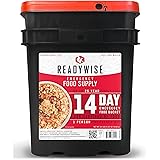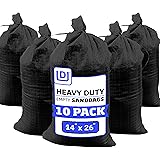Ensuring Adequate Food and Water Supply
Stockpiling Non-Perishable Foods
Trust me, there’s nothing worse than getting caught in an emergency and realizing you don’t have enough food to sustain you and your family. The first step in preparing for any emergency is making sure you have a well-stocked pantry. Stockpiling non-perishable foods like canned vegetables, beans, pasta, rice, and snack bars can be a lifesaver.
Don’t forget to rotate these items to keep them fresh. Every few months, check your stash and replace anything that’s close to expiring. This ensures that your food supply is always in top-notch condition and ready to go whenever disaster strikes.
Another thing I always emphasize is not to rely solely on your pantry. Consider MREs (Meals Ready-to-Eat) and dehydrated camping meals, which are designed to have long shelf lives and can be quite nutritious and filling when prepared correctly.
Water: Storage and Purification
Water is an absolute must-have in any emergency situation. You need to store at least one gallon of water per person per day, for at least three days. I personally recommend aiming for a two-week supply if space and resources allow. You can store water in clean, sealed containers or invest in bottled water.
If you run out of stored water, you’ll need a way to purify other water sources. Water purification tablets and filters can be life-savers. I’ve been in situations where a reliable water filter was the difference between dehydration and staying healthy. Learn how to use these tools effectively—they’re easy to use but practice makes perfect.
Also, don’t forget to consider other sources of water such as water heaters and toilet tanks, provided you know how to safely access and purify that water. This knowledge is crucial in prolonging your water supply during extended emergencies.
Special Dietary Needs
If anyone in your household has special dietary needs, make sure these are accounted for in your emergency food supply. This isn’t the time to try new foods; stick with what you know works. For instance, if someone is gluten intolerant, ensure your stockpile includes gluten-free options.
You also can’t forget about infants, elderly, or pets. Baby formula, special needs food for the elderly, and pet food should all be part of your planning. Trust me, it’s better to have more than less when it comes to these special requirements.
== > What if ... Get a FREE Subscription to PREPARE
In my own preparation, I also include multivitamins and supplements to make sure we can maintain our health even if our diet gets a bit monotonous. This added measure can make a critical difference in both physical and mental well-being during an emergency.
Creating a Communication Plan
Establishing Emergency Contacts
Communication is key when chaos ensues. One of the first things I did was establish a list of emergency contacts, both local and out-of-state. If cell lines are down or overloaded, you’ll need to know who to call or text first. Ensure everyone in your family knows how to get in touch with each other and with emergency services.
I also recommend having a written list of contacts—both digital copies and old-fashioned paper versions. In an emergency, you could lose power and your phone battery might die. A physical list can be a lifesaver, quite literally, in such a scenario.
Make sure to include crucial information such as doctor’s numbers, school contacts, and work contacts. Having this information readily available reduces stress and confusion during emergencies.
Designating a Meeting Point
Imagine this: your family is scattered across town when disaster strikes. How do you find each other? That’s why designating a meeting point is crucial. Pick two locations: one near your home in case of a sudden emergency and another farther away in case your neighborhood is not accessible.
Practice makes perfect. Conduct drills so everyone knows the route to these locations without a second thought. I’ve done this with my family a few times, and it really helps to iron out any issues you might not have even considered.
It’s also smart to have a backup plan. If the primary meeting point is inaccessible, make sure there’s an alternative location agreed upon. This planning can save you a lot of headaches and heartaches during an actual emergency.
Emergency Communication Devices
Your regular communication channels might be down during an emergency. That’s when having alternative options like two-way radios can be extremely useful. These devices have a range that can cover most neighborhoods and don’t rely on cell towers.
For longer-term solutions, consider satellite phones, albeit a bit pricy, they offer communication capabilities virtually anywhere. I also find texting, rather than calling, can be more reliable when networks are busy. Texts use less bandwidth and can often get through even when calls can’t.
Another neat trick is to use social media platforms’ safety check features. Most major platforms now have some form of check-in feature where you can mark yourself as safe, giving your loved ones peace of mind even if direct communication isn’t possible.
Assembling an Emergency Kit
Essential Medical Supplies
First aid should be a top priority. A well-stocked first aid kit can be the difference between a minor issue and a major crisis. I’m talking bandages, antiseptics, pain relievers, and any prescription medications you or your family might need. Don’t forget extras like tweezers and scissors.
Take it a step further by adding things like tourniquets and quick-clot pads for more serious injuries. These items can be a lifesaver while waiting for professional medical help. It wouldn’t hurt to take a basic first aid course either; the knowledge itself is priceless.
Consider the needs of anyone with medical conditions. For example, diabetics need insulin and testing supplies. If someone has asthma, include an extra inhaler. These essentials should be easily accessible and stored in a waterproof bag or container.
Tools and Equipment
An emergency kit isn’t complete without the right tools. Include a multi-tool, duct tape, and a sturdy flashlight with extra batteries. I’ve also found a whistle useful—it may seem trivial, but it can help signal for help if you’re trapped or need to get someone’s attention.
A portable phone charger, preferably one that’s solar-powered, can keep your devices active when electricity is down. You never know how long you’ll be without power, and staying connected is crucial for both information and comfort.
Make sure to include items like work gloves, a wrench, and pliers. These tools can help you turn off utilities or make quick repairs. I’ve used these tools more times than I’d like to admit, and they always come in handy.
Personal Care Items
In an emergency, maintaining personal hygiene can be a real morale booster. Pack items like toothpaste, biodegradable soap, hand sanitizer, and feminine hygiene products. You might not have access to showers or running water, so these can keep you feeling somewhat normal.
Also include comfort items like a deck of cards or a book. It might sound frivolous, but these can be mental lifesavers during long waits or stressful conditions. Anything that can help take your mind off the situation, even for a little while, is worth its weight in gold.
Last but not least, don’t forget to include copies of important documents like insurance papers, identification, and bank account information. Store them in waterproof containers. In the chaos of an emergency, having these documents easily accessible can expedite any processes that require them.
Understanding Evacuation Routes
Mapping Local Routes
If you need to leave your home in a hurry, knowing your evacuation routes is critical. Familiarize yourself with the local routes and know multiple ways to get to safety. GPS and mobile apps are great, but having a good old-fashioned paper map is invaluable if the digital options fail.
I’ve spent time driving and walking different routes to ensure I know the fastest and safest ways out. Practice these routes with your family. Make it a drill so everyone knows exactly which way to go without hesitation.
Local authorities often have designated evacuation routes and plans. Be sure to know these and stay updated through local news or community boards. Understanding these predetermined routes can significantly streamline your evacuation process.
Transportation Options
Your evacuation plan should account for different modes of transportation. If you have a car, make sure it’s well-maintained and has a full tank of gas. Keep a go-bag in the trunk, just in case you have to leave in a hurry without much notice.
If you don’t have a car, know your public transportation options. During certain emergencies, public transport might be free or specially routed to help people evacuate. Knowing the schedules and routes can be a huge advantage.
Another option to think about is car-pooling. If you have neighbors or friends nearby, make arrangements to evacuate together. This not only provides additional support but can also help in situations where one vehicle might be insufficient.
Emergency Shelters
Sometimes, relocating to a friend or family member’s house isn’t an option. That’s when emergency shelters come into play. Make sure you know the location of the nearest shelters and what you need to bring with you. Some shelters have specific requirements or might be pet-friendly while others are not.
I also make it a point to know what the shelters offer. Some provide food and medical care, while others might only offer a safe place to stay. Contact your local Red Cross or emergency management office for exact details.
Having an alternative like a tent or a pop-up shelter in your kit can also be useful, especially if the shelters are full or not easily accessible. This provides a last resort but can be very useful if you find yourself out of other options.
Frequently Asked Questions
What is the first thing I should do when preparing for an emergency?
The first step in emergency preparation is to assess your needs and start building an emergency kit that includes essential items like food, water, and medical supplies. Understanding what you need helps you prioritize and act efficiently.
How often should I update my emergency kit?
I recommend checking and updating your emergency kit at least every six months. Rotate out expired items and update any personal information as needed. Keeping your kit current ensures you’re always ready for any situation.
How do I create a communication plan?
Start by making a list of important contacts, designate a meeting place, and ensure everyone in your family understands the plan. Consider alternative communication methods like two-way radios or satellite phones to stay in touch when traditional networks fail.
What should I do if I’m separated from my family during an emergency?
Having a pre-designated meeting point and a clear communication plan is essential. Make sure everyone knows where to go and who to contact. Practicing this plan periodically can help ensure everyone acts quickly and safely during a real emergency.






